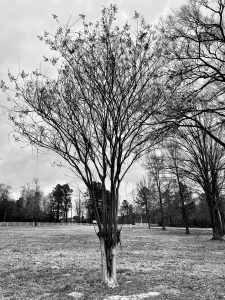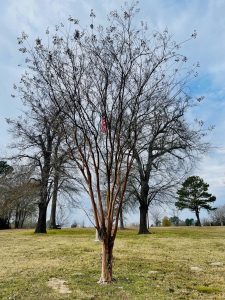Stop Mutilating the Myrtles!
by admin | January 21, 2022 6:43 am
As I drove to work earlier this week, I spied a familiar if discouraging sight. Perched on top of a step ladder that was listing dangerously to the left, a landscape worker brandished some shears with which he was mutilating a crape myrtle tree. He lopped off the previous year’s growth to leave an amputated tree topped with knobs, from which spindly branches will eventually emerge, often not strong enough to hold their heads up in a summer rain.
If it’s January in East Texas, it is time to send landscapers out across residential lawns and businesses to murder myrtles (it’s not strictly murder but does put the myrtle at risk for disease). A mistaken belief exists that this improves the production of blossoms. As I have done sporadically over the past 20-odd years, I am writing to tell folks this is totally unnecessary. Save your money. Leave the crepe myrtles alone to grow naturally. Depending on the type plan

ted, they can grow 30-40 feet high.
The other day I was on the second floor of the Gregg County Courthouse, waiting to register a vehicle. The courthouse lawn is always beautifully manicured. Flanking its entrance are crepe myrtles that reach to the second floor, visible inside from the large windows. They are magnificent trees. But not if they are mutilated every January by landscapers who don’t have much to do when the grass lies fallow. Happily, the courthouse myrtles are left alone.
My epiphany came while living alone in a modest house in Nacogdoches. One unseasonably warm January afternoon (these are beginning to occur so often they may soon not be unseasonable, but that is a topic for another time), I climbed up a step ladder and pruned the crepe myrtles growing in the back yard. It was hot, sweaty work, and I managed to pull a muscle in my back in the process
A few days later at work at the Daily Sentinel, I complained about what a chore pruning crepe myrtles could be. Our gardening columnist overheard me, spun around (as I recall), and began gently lecturing me on how unnecessary it was to mutilate crepe myrtles. Eventually, I joined his organization and slapped a “Stop Myrtle Mutilation” bumper sticker on my Jeep. Several houses later, any crepe myrtles on the property go unscathed, and I can spend that time in more fruitful endeavors – like taking a nap.
Google “crepe murder” some time. You will find dozens of pages decrying the practice of myrtle mutilation as an unnecessary disfiguration of this lovely tree that has become emblematic of the South.
There is some discrepancy over the spelling. The scientific name is lagerstroemia crape myrtle, so in most of the United States it is spelled “crape.” However, here in the South, it is usually spelled “crepe” because the blooms resemble crepe paper. At least that is what I read. I thought it had something to do with crepe suzettes. Southern Living magazine uses “crepe,” and that’s good enough for me. We can peacefully differ with those who prefer “crape.” What is not up for debate: Myrtle mutilation is utterly unnecessary. What is also not up for debate: Most folks are going to keep on doing it.
One argument made by myrtle mutilators is the tree will get too tall and hit a power line, or they’re planted so close to a house that they’ll grow up into the soffit if not trimmed. Crepe myrtles come in many varieties from “tall” to “dwarf” and in between. If you don’t want your myrtle to grow to 30 feet tall, plant one of the shorter varieties and leave it alone.

Aahh, but it is not too late for some of you reading this to reform your ways. You have been paying landscape crews to murder your myrtles for years. All is not lost. It will take a few years, but eventually you can also have pleasing crepe myrtles without amputating the upper limbs down to the knobs every winter. Go here[1] to find out how.
Now put those pruning shears away and go take a nap.
- here: https://landscapeworkshop.com/have-you-committed-crape-murder/
Source URL: https://garyborders.com/pages/stop-mutilating-the-myrtles/